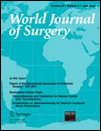Preoperative Assessment of the Pancreas in Multiple Endocrine Neoplasia Type 1
Abstract
Background
Many serologic and radiographic modalities are used for monitoring multiple endocrine neoplasia type 1 (MEN 1) patients for pancreaticoduodenal neuroendocrine tumors (PNETs). We compared serum markers and imaging studies obtained preoperatively with the gross pathology and immunohistochemical findings and correlated preoperative testing with postoperative outcome.
Methods
From 2000 to 2008, 52 MEN 1 patients [32 (62%) female; median age = 43 years, range 19–74 years] underwent 56 pancreatic operations [49 (88%) distal pancreatectomies] for suspected PNETs. Preoperative serum markers [human pancreatic polypeptide (HPP), gastrin, and glucagon] and imaging [CT, 111In pentetreotide scintigraphy, and endoscopic ultrasound (EUS)] were compared to the pathologic findings. Postoperative serum markers and survival were followed.
Results
Human pancreatic polypeptide had the highest agreement between an elevated serum level and positive tumor immunostaining (83% vs. 50% agreement for gastrin vs. 67% agreement for glucagon). Preoperative CT had 81% sensitivity and positive predictive value (PPV) of 97% for PNETs. 111In pentetreotide scintigraphy had 84% sensitivity and PPV of 96%. Preoperative endoscopic ultrasonography (EUS) had 100% sensitivity and PPV, with close correlation (rs = 0.93) between the largest lesion seen on EUS and pathology. Median follow-up was 4.3 years (range = 0.1–10.9 years). Overall survival was 89% at 5-year follow-up.
Conclusions
Our study substantiates EUS as providing the highest preoperative sensitivity and PPV in assessing the presence of PNETs in MEN 1 patients. CT and octreotide scintigraphy can yield both false-positive and false-negative results. HPP, gastrin, and glucagon were the most commonly measured tumor markers in our series but did not always correlate with immunostaining. With an aggressive surgical approach, satisfactory rates of biochemical improvement and long-term survival were observed.
Conflict of interest
The authors have no conflicts of interest to disclose.




